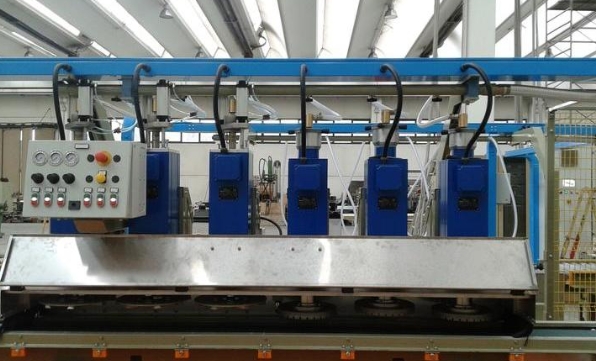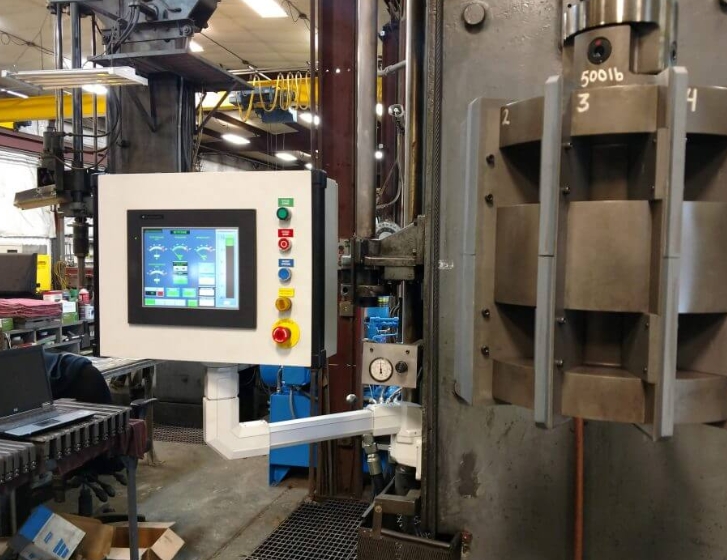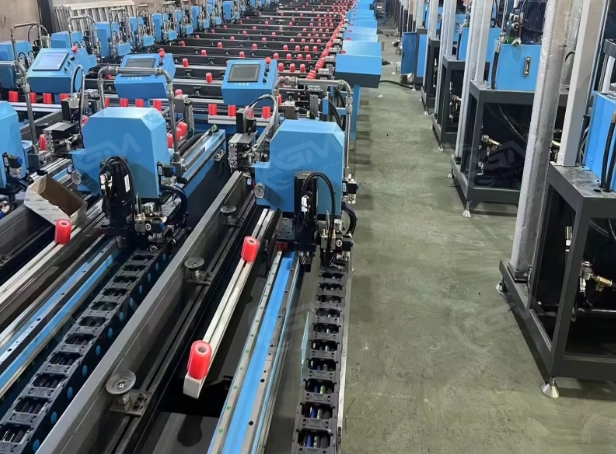Content Menu
● Understanding Extrusion Line Equipment
● The Importance of Maintenance for Extrusion Line Equipment
● Key Maintenance Strategies
>> Daily Maintenance Tasks
>> Weekly and Monthly Maintenance
>> Quarterly and Annual Maintenance
>> Long-Term and Preventive Maintenance
● Common Maintenance Challenges and Solutions
>> 1. Wear and Tear of Screws and Barrels
>> 2. Lubrication Failures
>> 3. Electrical System Issues
>> 4. Cooling System Inefficiencies
>> 5. Misalignment and Vibration
● Preventive Maintenance Schedule Example
● Leveraging Technology in Maintenance
● Troubleshooting Common Extrusion Line Equipment Issues
● Best Practices for Long-Term Performance
● Conclusion
● FAQ
>> 1. How often should I perform a complete overhaul of my extrusion line equipment?
>> 2. What are the most common signs that extrusion line equipment needs immediate maintenance?
>> 3. How can I improve the energy efficiency of my extrusion line equipment through maintenance?
>> 4. What safety precautions should be taken during maintenance of extrusion line equipment?
>> 5. How can I extend the life of extrusion dies and other critical components?
● Citations:
Maintaining extrusion line equipment is essential for ensuring consistent product quality, maximizing operational efficiency, and extending equipment lifespan. Whether you operate a plastic, aluminum, or PE extrusion line, a proactive and systematic maintenance approach will minimize downtime, reduce costly repairs, and support continuous production. This comprehensive guide details best practices, schedules, and troubleshooting tips for maintaining extrusion line equipment, drawing on industry expertise and current recommendations.

Understanding Extrusion Line Equipment
Extrusion line equipment refers to the integrated system of machines used to shape raw materials—such as plastics, metals, or rubber—into continuous profiles. The typical extrusion line includes:
- Extruder: The core machine that melts and pushes material through a die.
- Die: Shapes the molten material into the desired profile.
- Cooling System: Solidifies the extrudate.
- Haul-Off Unit: Pulls the product through the line at a controlled speed.
- Cutting/Finishing Units: Finalizes the product for packaging or further processing.
Each component must work in harmony for optimal performance, making regular maintenance indispensable.
The Importance of Maintenance for Extrusion Line Equipment
Proper maintenance of extrusion line equipment delivers several benefits:
- Reduces unplanned downtime
- Improves product quality and consistency
- Extends equipment lifespan
- Enhances energy efficiency
- Lowers long-term operational costs
Neglecting maintenance can lead to increased wear, frequent breakdowns, safety hazards, and compromised product quality[3][4][7].
Key Maintenance Strategies
Daily Maintenance Tasks
- Visual Inspections: Conduct walk-around checks for leaks, unusual noises, or visible wear[3][4].
- Lubrication: Ensure all moving parts—such as bearings, gearboxes, and rollers—are properly lubricated with manufacturer-recommended oils or greases[1][3][4][7].
- Cleaning: Remove dust, debris, and material buildup from the extruder, die, and cooling systems to prevent contamination and blockages[1][4][7].
- Monitor Parameters: Track temperature, pressure, and speed; address any deviations immediately[3][7].
- Check Safety Devices: Test emergency stops and safety interlocks to ensure functionality[5].
Weekly and Monthly Maintenance
- Inspect Transmission Components: Check gearboxes, belts, and couplings for wear, misalignment, or leaks[5].
- Calibrate Sensors: Verify the accuracy of temperature, pressure, and speed sensors; recalibrate as needed[7].
- Filter Replacement: Change oil and air filters in hydraulic and lubrication systems to prevent contamination[1][3].
- Cooling System Maintenance: Clean cooling tanks, heat exchangers, and replace water to avoid scaling and blockages[1][7].
- Electrical Checks: Inspect wiring, connections, and control panels for signs of wear or overheating[3][5].
Quarterly and Annual Maintenance
- Comprehensive Overhaul: Disassemble major components (e.g., screw, barrel, die head) for thorough inspection, cleaning, and measurement of wear[2][4][6].
- Gearbox Service: Change oil, inspect gears and bearings, and clean the oil sump for metal particles[1][5][6].
- Alignment and Leveling: Check and adjust alignment of the extruder, dies, and haul-off units to prevent uneven wear and product defects[3][7].
- Non-Destructive Testing: Use techniques like vibration analysis or ultrasonic testing to detect hidden fatigue or cracks in structural components[3].
- Safety Audit: Review all safety systems, guards, and emergency procedures to ensure compliance and operator protection[3].
Long-Term and Preventive Maintenance
- Develop a Maintenance Schedule: Create a detailed plan based on manufacturer recommendations, operational hours, and historical data[3][7].
- Train Operators: Ensure all staff are trained in both operation and maintenance procedures to foster accountability and early problem detection[4][3].
- Document Maintenance Activities: Keep accurate records of inspections, repairs, and parts replacements for future reference and continuous improvement[3].
- Spare Parts Inventory: Maintain a stock of critical spare parts to minimize downtime during repairs[1].

Common Maintenance Challenges and Solutions
1. Wear and Tear of Screws and Barrels
- Solution: Regularly inspect for wear, scoring, or deformation. Replace or refurbish parts that reach wear limits. Apply anti-rust grease during long shutdowns[1][2][4][6].
2. Lubrication Failures
- Solution: Follow a strict lubrication schedule, use appropriate lubricants, and monitor oil levels and temperatures. Address leaks or contamination promptly[1][3][6].
3. Electrical System Issues
- Solution: Inspect and clean control panels, replace aging components, and ensure all connections are secure. Calibrate instruments regularly[1][3][5].
4. Cooling System Inefficiencies
- Solution: Clean and descale cooling channels, check for leaks, and ensure proper coolant flow. Replace water and clean tanks regularly[1][7].
5. Misalignment and Vibration
- Solution: Perform routine alignment checks and vibration analysis. Address misalignment immediately to prevent further damage[3][7].
Preventive Maintenance Schedule Example
| Frequency | Task |
| Daily | Visual inspection, lubrication, cleaning, monitor parameters |
| Weekly | Inspect gearboxes, belts, couplings; check filters and cooling tanks |
| Monthly | Calibrate sensors, replace filters, inspect electrical panels |
| Quarterly | Overhaul major components, gearbox service, alignment checks |
| Annually | Comprehensive safety audit, full system overhaul |
Leveraging Technology in Maintenance
Modern extrusion line equipment benefits from advanced maintenance technologies:
- IoT Sensors: Real-time monitoring of temperature, pressure, and vibration for predictive maintenance[3].
- Computerized Maintenance Management Systems (CMMS): Schedule, track, and document maintenance tasks efficiently[3].
- Augmented Reality: Remote guidance and training for maintenance staff[3].
- Predictive Analytics: AI-driven insights to anticipate failures and optimize maintenance schedules[3].
Troubleshooting Common Extrusion Line Equipment Issues
- Unusual Noises: May indicate bearing failure, misalignment, or foreign objects. Stop and investigate immediately[3][4][6].
- Inconsistent Product Quality: Check die alignment, temperature control, and material feed consistency[3][7].
- Hydraulic Leaks: Inspect seals, hoses, and fittings; replace as necessary[3].
- Frequent Breakdowns: Review maintenance records, identify recurring issues, and implement corrective actions[3][7].
Best Practices for Long-Term Performance
- Consistency: Adhere to maintenance schedules without exception.
- Attention to Detail: Small issues can escalate; address them early.
- Operator Involvement: Empower operators to perform basic checks and report anomalies[4].
- Continuous Improvement: Use maintenance data to refine schedules and procedures[3].
Conclusion
Maintaining extrusion line equipment for long-term performance requires a structured, proactive approach that encompasses daily care, scheduled inspections, and comprehensive overhauls. By investing in operator training, leveraging modern technology, and adhering to a rigorous maintenance schedule, you can maximize equipment lifespan, minimize downtime, and ensure consistent product quality. The key is consistency, vigilance, and a culture of continuous improvement—turning maintenance from a cost into a strategic advantage.

FAQ
1. How often should I perform a complete overhaul of my extrusion line equipment?
A complete overhaul is typically recommended every 3–5 years, depending on usage intensity, operating conditions, and manufacturer guidelines. Consult your equipment manual and maintenance records to determine the optimal interval for your specific extrusion line equipment[3].
2. What are the most common signs that extrusion line equipment needs immediate maintenance?
Warning signs include unusual noises or vibrations, decreased product quality, increased hydraulic fluid consumption, frequent breakdowns, and visible wear or damage to components. If any of these symptoms appear, schedule an inspection immediately to prevent further damage[3][4].
3. How can I improve the energy efficiency of my extrusion line equipment through maintenance?
Regularly maintain hydraulic seals to prevent leaks, ensure proper lubrication to reduce friction, optimize heating systems and insulation, maintain alignment of all components, and keep cooling systems clean for optimal heat transfer. These steps will reduce energy waste and improve overall efficiency[3].
4. What safety precautions should be taken during maintenance of extrusion line equipment?
Always follow lockout/tagout procedures, wear appropriate personal protective equipment (PPE), release all hydraulic pressure before maintenance, use proper lifting equipment for heavy parts, and adhere to all safety guidelines outlined in the equipment manual[3][4].
5. How can I extend the life of extrusion dies and other critical components?
Clean dies thoroughly after each use, store them properly to prevent damage, regularly inspect for wear, use appropriate lubricants, maintain proper alignment, and follow the recommended maintenance schedule for die care. These practices will significantly extend the life of your extrusion dies and related equipment[3].
Citations:
[1] https://www.jwellextrusions.com/tips-for-maintaining-plastic-extrusion-equipment-in-winter.html
[2] http://www.chinaextruders.com/m/article/mojmFqLp6gSj.html
[3] https://www.yjing-extrusion.com/how-to-maintain-an-aluminum-extrusion-press-for-optimal-performance.html
[4] https://www.polytechmachine.com/info/daily-maintenance-of-plastic-extrusion-product-97684149.html
[5] https://extrusion.4spe.org/wp-content/uploads/2019/01/Vol26-01-02-Extruder-Maintenance-SPE-Extrusion-Division-1-0-Wiki.pdf
[6] https://www.medicalextruders.com/info/extrusion-equipment-maintenance-method-24455647.html
[7] https://www.polestar-machinery.com/news/essential-maintenance-tips-for-pe-extrusion-lines/
[8] https://jydjx.com/effective-maintenance-strategies-for-plastic-extrusion-machines/
[9] https://www.spssolutions.nl/how-efficiently-runs-your-extrusion-line/?lang=en
[10] https://www.grahamengineering.com/about/ge-connect/proper-extruder-maintenance-a-key-to-success/
[11] https://www.ulprospector.com/knowledge/9293/pc-predictive-maintenance-troubleshooting-plastics-extrusion-equipment/
[12] https://www.conairgroup.com/resources/resource/extrusion-processing-basic-guide-to-auxiliary-equipment/
[13] https://jieyatwinscrew.com/blog/unlocking-the-secrets-of-the-extrusion-line/
[14] https://www.medicalextruders.com/info/extrusion-equipment-maintenance-method-24455647.html
[15] https://www.accextrusion.com/news/operating-plastic-profile-extrusion-machines/
[16] https://www.cowinextrusion.com/tips-for-operating-and-debugging-the-extruder/
[17] https://www.linkedin.com/pulse/nine-main-points-aluminum-extrusion-press-machine-maintenance-
[18] https://www.prm-taiwan.com/blog/essential-tips-for-choosing-best-pvc-pipe-extrusion-line_508
[19] https://www.jwellmachine.com/china-extruder-machine-maintenance-method/
[20] https://www.linkedin.com/pulse/crucial-considerations-acquiring-pipe-extrusion-machinery-zsluc
[21] https://jydjx.com/important-maintenance-steps-for-maintaining-a-plastic-pipe-extrusion-line/
[22] https://crewhr.com/interview-questions/extruding-operators/
[23] https://www.linkedin.com/pulse/6-general-problems-extruder-related-solution-w-jennifer
[24] https://pubs.aip.org/aip/acp/article-pdf/doi/10.1063/1.4965491/13728906/030021_1_online.pdf
[25] https://www.plastar-machine.com/en/news/faq.html
[26] https://www.bausano.com/en/press-and-news/common-problems-in-the-plastic-extrusion-process
[27] https://www.leadertw.com/faq.htm
[28] https://www.pearltechinc.com/2025/02/13/extrusion-equipment-blown-film-efficiency/
[29] https://www.andersonintl.com/proven-best-practices-for-maintaining-a-high-shear-extruder-machine/
[30] https://www.jwellmachine.com/winter-maintenance-tips-for-plastic-extrusion-equipment/
[31] https://www.faygounion.com/news/5-ways-to-improve-efficiency-in-plastic-extrusion-lines/
[32] https://www.jwellextrusions.com/tips-for-maintaining-plastic-extrusion-equipment-in-winter.html
[33] https://www.jwellextrusions.com/common-problems-and-solutions-of-pe-pipe-extrusion-line.html
[34] https://s3.amazonaws.com/entecpolymers.com/v3/uploads/content/Extrusion-Troubleshooting-Guide.pdf






















